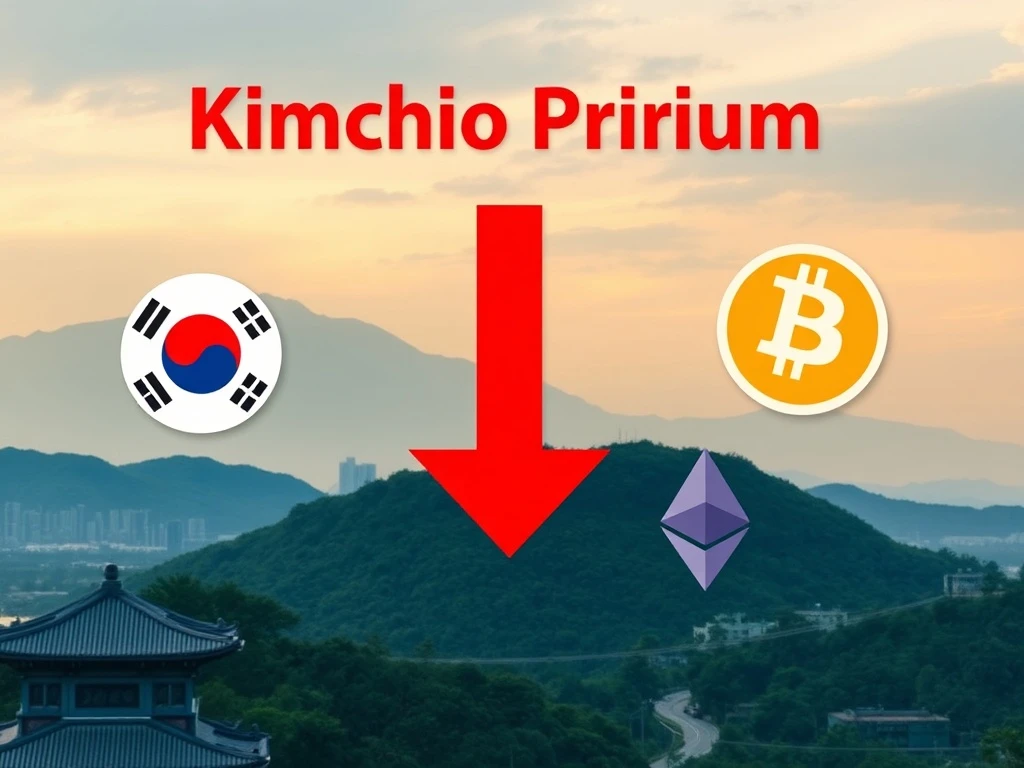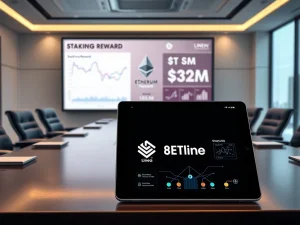Bitcoin Kimchi Premium Plummets: South Korea’s Surprising Market Shift Unpacked

The cryptocurrency world is buzzing with a rare occurrence: the infamous Kimchi Premium, a historical hallmark of South Korean crypto markets, has flipped negative. For the first time in a significant period, Bitcoin’s price on South Korean exchanges is notably lower than on international platforms. This unexpected turn of events, marking a -0.52% negative Bitcoin Kimchi Premium, signals a profound shift in global crypto market dynamics and warrants a closer look.
What is the Bitcoin Kimchi Premium and Why Does it Matter?
Historically, the ‘Kimchi Premium’ refers to the phenomenon where cryptocurrency prices, especially Bitcoin, trade at a higher price on South Korean exchanges compared to global exchanges. This premium was often attributed to a combination of factors:
- High Domestic Demand: A strong appetite for crypto among South Korean retail investors.
- Capital Controls: Strict regulations making it difficult to move funds in and out of the country, limiting arbitrage opportunities.
- Limited Liquidity: A somewhat isolated market with less direct influence from global liquidity pools.
This premium often presented an arbitrage opportunity for traders who could legally bridge the price gap. A negative Kimchi Premium, however, reverses this narrative entirely, indicating that local prices are now lagging, not leading. This inversion is a critical indicator for understanding the evolving South Korea crypto landscape.
Unpacking South Korea’s Crypto Market Dynamics: A Rare Inversion
On July 26, 2025, at 12:00 AM KST, Bitcoin on Upbit, South Korea’s leading platform, was priced at 158.46 million KRW. This represented a 1.54% daily decline. In stark contrast, Binance, a major global exchange, listed Bitcoin at 159.29 million KRW. This created a significant 830,000 KRW price gap, leading to the -0.52% negative Kimchi Premium. This shift challenges the long-held belief that South Korean markets are price leaders, suggesting a fundamental change in how their crypto ecosystem interacts with the rest of the world.
The Broad Impact: Altcoin Discounts and Market Trends
The negative premium wasn’t isolated to Bitcoin. The trend extended across the broader market, impacting major altcoins:
- Ethereum (ETH): Registered a -0.53% discount.
- Solana (SOL): Experienced a negative premium.
- XRP, Dogecoin (DOGE), Shiba Inu (SHIB): All followed suit, posting premiums between -0.42% and -0.57%.
In fact, over 90% of the top altcoins traded at a discount of -0.4% or lower. This widespread effect suggests a systemic shift rather than mere isolated fluctuations in individual assets. The presence of an altcoin discount alongside Bitcoin’s negative premium points to a broader change in domestic demand or an increase in cross-border liquidity flows.
What’s Driving This Arbitrage Activity and Market Shift?
While specific triggers remain unconfirmed, several factors could be contributing to this unprecedented negative Kimchi Premium and the subsequent arbitrage activity:
- Increased Global Liquidity: It’s possible that South Korean investors are finding easier or more cost-effective ways to access global exchanges, increasing liquidity flow from international markets into South Korea.
- Reduced Domestic Demand: A decline in local investor sentiment or a shift in investment preferences within South Korea could lead to lower domestic demand relative to global markets.
- Regulatory Adjustments: Although not explicitly stated, any recent or anticipated changes in South Korean crypto regulations could impact capital flows and market behavior.
- Market Efficiency: As crypto markets mature and become more interconnected, arbitrage opportunities naturally shrink. This could be a sign of increasing market efficiency, where price discovery becomes more centralized globally.
Analysts note that such inversions are rare and typically short-lived. However, a prolonged period of discounts could signal structural changes in cross-border trading patterns, making it a crucial development for traders and investors to monitor.
Navigating New Crypto Market Dynamics: Implications for Traders
The emergence of a negative Kimchi Premium fundamentally alters the traditional trading landscape. For traders, understanding these new crypto market dynamics is key:
- Arbitrage Reversal: The traditional arbitrage strategy of buying low globally and selling high in Korea is now reversed. New opportunities might arise from selling in Korea and buying on global exchanges, though execution complexities remain.
- Market Interconnectedness: This event underscores the growing interconnectedness of global and regional crypto markets. Local price deviations are becoming less sustainable, leading to more synchronized price movements.
- Data Monitoring: Traders should closely monitor real-time price data across various exchanges, both domestic and international, to identify any emerging trends or short-lived arbitrage windows.
- Regulatory Watch: Keeping an eye on regulatory developments in South Korea and other major crypto hubs is crucial, as policy changes can significantly impact market premiums and discounts.
As price discovery potentially becomes more centralized, the role of local exchanges in setting global prices may diminish, leading to a more unified global crypto market.
The negative Kimchi Premium is a compelling development in the cryptocurrency space. It signals a potential maturation of the South Korean market, challenging its historical isolation and price leadership. While the full implications are still unfolding, this event highlights the increasing interconnectedness of global crypto markets and the constant evolution of trading dynamics. Traders and investors should remain vigilant, adapting their strategies to these new realities as the market continues to flux.
Frequently Asked Questions (FAQs)
Q1: What is the Kimchi Premium in cryptocurrency?
The Kimchi Premium is a phenomenon where cryptocurrency prices, particularly Bitcoin, trade at a higher price on South Korean exchanges compared to global exchanges. It historically indicated strong local demand and capital controls.
Q2: Why has the Bitcoin Kimchi Premium turned negative?
The recent negative Bitcoin Kimchi Premium suggests that South Korean prices are now lower than global prices. This could be due to increased liquidity from global exchanges, reduced domestic demand in South Korea, or evolving regulatory pressures, though specific triggers are unconfirmed.
Q3: Does a negative Kimchi Premium affect altcoins too?
Yes, the article states that the negative premium extended to major altcoins like Ethereum, Solana, XRP, Dogecoin, and Shiba Inu, with over 90% of top altcoins trading at a discount. This indicates a broad market shift rather than isolated fluctuations.
Q4: What does this mean for arbitrage opportunities?
A negative Kimchi Premium reverses traditional arbitrage opportunities. Instead of buying globally and selling in Korea, new opportunities might involve selling in Korea and buying on global exchanges, though this requires careful consideration of execution and regulatory compliance.
Q5: Is a negative Kimchi Premium a common occurrence?
No, analysts note that such inversions are rare and typically short-lived. A prolonged period of negative premium could signal more structural changes in cross-border trading patterns and market interconnectedness.
Q6: How does this impact the global crypto market?
The negative Kimchi Premium underscores the growing interconnectedness of global and regional crypto markets. As arbitrage opportunities shrink, price discovery is becoming more centralized, potentially reducing the role of local exchanges in setting global prices and leading to a more unified market.










